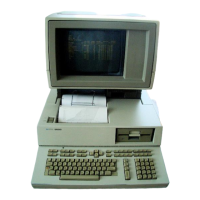2-30
Theory
of
Operation
Keyboard
The keyboard
is
a microprocessor-controlled assembly consisting of two boards, a keyboard elec-
tronics
board
and
a keyswitch board (Figure 2-19). The assembly plugs into three ribbon cable
connectors
mounted
in
the base of the computer. The assembly connectors are as follows:
C -
50-pin; lOP bus
PC - 50-pin; power
and
miscellaneous signals
TB
- 14-pin; optional input device interface
The
keyboard
electronics
board
and
keyswitch
board
are physically interconnected
by
screws
and
a 20-pin ribbon cable.
The
ribbon cable
is
the keyboard bus which functionally intercon-
nects the boards.
The keyswitch board contains the keyswitches
and
minimal electronics
needed
to scan the key
matrix. The keyboard electronics board contains an
8048
microprocessor which scans the key
matrix, the real-time clock/non-volatile memory (RTC/NVM), the programmable tone generator
(beeper) the optional input device,
and
the lOP bus interface.
Select code 6 (SC6) provides access to the printer, keyboard, RTC/NVM, optional input device,
and
the beeper. Each of these devices has
one
or more interface register(s) assigned to
it.
The
device can be read from or written to by accessing the assigned interface register. The interface
registers are designated as
RX
registers.
To eliminate bus conflicts with the printer, which has
its
own bus interface circuitry, the lOP bus
drivers are enabled only when registers R1,
R3,
R9, R10, R11, R12,
and
R15 are accessed. The
printer's bus drivers are enabled when registers
RO,
R1, R2, R4, R5, R6,
and
R7 are accessed.
R1
is
shared, with the keyboard driving the lower 12 hits
and
the printer driving the upper 4 bits. For
R12, only the lower 8-bit bus buffer
is
enabled
on
the keyboard
for
both reads
and
writes.
NSTATUS
and
NFLAG for
all
of select code 6 are driven from the keyboard. Printer STATUS
and
FLAG are sent to the keyboard
on
the 50-pin ribbon cable carrying power to both assemblies.
The keyboard electronics board contains a nickel-cadmium
(NICAD)
battery assembly to maintain
the RTC/NVM data during periods of
no
mainframe power. The battery assembly has a minimum
life
expectancy of approximately 4 years.
It
can maintain the data during a power-off condition for a
minimum of
10
days.
The keyboard circuitry, contained
on
the keyboard electronics board, can be divided into six main
subsections. Five of these subsections interface to a comtnon internal bi-directional data bus. The
remaining subsection interfaces the data bus to the lOP bus. The six subsections are:
• lOP Bus Interface
• Miscellaneous Status
and
Control
• Keyboard
and
Input Device Scanning
• Beeper
• RTC/NVM Logic
and
Enable
• Power-Up/Power-Down Sense Circuitry

